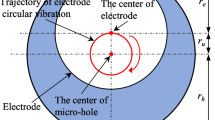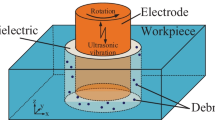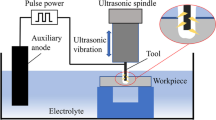Abstract
Ultrasonic vibration-assisted electrical discharge machining (EDM) as an alternative advanced processing technology has been widely used to machine micro-hole arrays. However, there exists a concentration of debris particles in the discharge gap, which affects the machining accuracy of micro-hole arrays by ultrasonic vibration-assisted EDM with tool electrode arrays. In this study, a series of experiments of ultrasonic vibration-assisted EDM of micro-hole arrays with tool electrode arrays were performed, and the experimental results demonstrate that the hole diameter in the central holes of hole arrays is a little bigger than those in the peripheral holes of hole arrays. To illustrate the mechanism of hole diameter non-uniformity of micro-hole arrays by ultrasonic vibration-assisted EDM with tool electrode arrays, a three-dimensional gap flow field model for ultrasonic vibration-assisted EDM of micro-hole arrays was proposed based on computational fluid mechanics. In the flow field model, the laws of flow field velocity and debris particles distribution were simulated numerically under the effect of ultrasonic vibration. To investigate the rules of flow field velocity and debris particles distribution during ultrasonic vibration-assisted EDM of micro-hole arrays, the flow field model of 3 × 3 micro-hole arrays, 5 × 5 micro-hole arrays, and 10 × 10 micro-hole arrays were considered. The numerical simulation results show that in the flow field, the concentration degree of debris particles in the peripheral holes of micro-hole arrays is lower than those of the central holes of micro-hole arrays. The non-uniformity distribution of debris particles of the central holes and the peripheral holes of micro-hole arrays strength the local electric field and leads to non-uniformity of discharge breakdown probability, which causes the hole diameter non-uniformity of micro-hole arrays by ultrasonic vibration-assisted EDM. The experimental and numerical simulation results reveal the mechanism of hole diameter non-uniformity of micro-hole arrays by ultrasonic vibration-assisted EDM with tool electrode arrays and suggest that decreasing the concentration of debris particles is the effective way to improve the performance of EDM of micro-hole arrays.







Similar content being viewed by others
Data availability
Not applicable.
References
Mao X, Wang X, Li C, Mo J, Ding S (2020) Effects of stepped cylindrical electrode in electrical discharge machining of blind holes. Int J Adv Manuf Technol 110:1457–1469. https://doi.org/10.1007/s00170-020-05941-3
Belloufi A, Mezoudj M, Abdelkrim M, Rezgui I, Chiba E (2020) Experimental and predictive study by multi-output fuzzy model of electrical discharge machining performances. Int J Adv Manuf Technol 109:2065–2093. https://doi.org/10.1007/s00170-020-05718-8
Renjie J, Yonghong L, Suet T, Hui J, Sze YW, Zelin Y, Chao Z, Baoping C (2018) Efficient fabrication of gradient nanostructure layer on surface of commercial pure copper by coupling electric pulse and ultrasonics treatment. J Alloys Compd 764:51–61. https://doi.org/10.1016/jjallcom201806042
Takahata K, Gianchandani YB (2002) Batch mode micro-electro-discharge machining. J Microelectromech S 11(2):102–110. https://doi.org/10.1109/84993444
Goiogana M, Sarasua JA, Ramos JM (2018) Ultrasonic assisted electrical discharge machining for high aspect ratio blind holes. Procedia CIRP 68:81–85. https://doi.org/10.1016/jprocir201712026
Hsue WJ, Hao TJ (2016) Comparison on gas bubble and pulse trains of deep-cavity electrical discharge machining with/without rotary ultrasonic assistance. Int J Adv Manuf Technol 87:2153–2164. https://doi.org/10.1007/s00170-016-8557-9
Zhang C, Zou R, Yu Z, Natsu W (2020) Micro EDM aided by ultrasonic vibration in nitrogen plasma jet and mist. Int J Adv Manuf Technol 106:5269–5276. https://doi.org/10.1007/s00170-020-05032-3
Lin YC, Hung JC, Chow HM, Wang AC, Chen JT (2016) Machining characteristics of a hybrid process of EDM in gas combined with ultrasonic vibration and AJM. Procedia CIRP 42:167–172. https://doi.org/10.1016/jprocir201602213
Li Z, Bai J, Cao Y, Wang Y, Zhu G (2019) Fabrication of microelectrode with large aspect ratio and precision machining of micro-hole array by micro-EDM. J Mater Process Technol 268:70–79. https://doi.org/10.1016/jjmatprotec201901009
Zeng W, Wang Z, Weng M, Liu Y (2012) Micro-electrode array and micro-hole array fabrication by combined micro-WEDM and EMM. Dig J Nanomater Bios 7(2):755–761. https://doi.org/10.1016/jphyse201112021
Tsai MY, Fang CS, Yen MH (2018) Vibration-assisted electrical discharge machining of grooves in a titanium alloy (Ti-6A-4V). Int J Adv Manuf Technol 97:297–304. https://doi.org/10.1007/s00170-018-1904-2
Cetin S, Okada A, Uno Y (2004) Effect of debris distribution on wall concavity in deep-hole EDM. JSME Int J 47(2):553–559. https://doi.org/10.1299/jsmec47553
Wang J, Han F (2014) Simulation model of debris and bubble movement in consecutive-pulse discharge of electrical discharge machining. Int J Mach Tool Manu 77:56–65. https://doi.org/10.1007/s00170-014-6008-z
Mastud S, Kothari NS, Singh RK, Joshi SS (2015) Modeling debris motion in vibration assisted reverse micro electrical discharge machining process (R-MEDM). J Microelectromech S 24(3):661–676. https://doi.org/10.1109/JMEMS20142343227
Pattabhiraman A, Marla D, Kapoor SG (2016) A computational model to study film formation and debris flushing phenomena in spray-electric discharge machining. J Micro Nano Manuf 4(3):031002–031012. https://doi.org/10.1115/14033709
Tanjilul M, Ahmed A, Kumar AS, Rahman M (2017) A study on EDM debris particle size and flushing mechanism for efficient debris removal in EDM-drilling of inconel 718. J Mater Process Technol 255:263–274. https://doi.org/10.1016/jjmatprotec201712016
Shabgard MR, Gholipoor A, Mohammadpourfard M (2018) Numerical and experimental study of the effects of ultrasonic vibrations of tool on machining characteristics of EDM process. Int J Adv Manuf Technol 96:2657–2669. https://doi.org/10.1007/s00170-017-1487-3
Shitara T, Fujita K, Yan J (2020) Direct observation of discharging phenomena in vibration-assisted micro-electrical discharge machining. Int J Adv Manuf Technol 108(4):1–14. https://doi.org/10.1007/s00170-019-04877-7
Talla G, Gangopadhyay S, Kona NB (2017) Experimental investigation and optimization during the fabrication of arrayed structures using reverse EDM. Mater Manuf Process 32(9):958–969. https://doi.org/10.1080/10426914.2016.1221085
Murray JW, Sun J, Patil DV, Wood TA, Clare AT (2016) Physical and electrical characteristics of EDM debris. J Mater Process Technol 229:54–60. https://doi.org/10.1016/j.jmatprotec.2015.09.019
Funding
This research was funded by the National Natural Science Foundation of China (NSFC) (No.51605123).
Author information
Authors and Affiliations
Contributions
Conceived of the presented idea, B.X.; Y.Z. and B.X. discussed the results and contributed to the final manuscript; B.X. wrote the manuscript with support from Y.Z. All authors have read and agreed to the published version of the manuscript.
Corresponding author
Ethics declarations
Conflict of interest
The authors declare that they have no conflict of interest.
Ethical approval and consent to participate
Not applicable.
Additional information
Publisher’s note
Springer Nature remains neutral with regard to jurisdictional claims in published maps and institutional affiliations.
Rights and permissions
About this article
Cite this article
Zhang, Y., Xie, B. Investigation on hole diameter non-uniformity of hole arrays by ultrasonic vibration-assisted EDM. Int J Adv Manuf Technol 112, 3083–3091 (2021). https://doi.org/10.1007/s00170-021-06597-3
Received:
Accepted:
Published:
Issue Date:
DOI: https://doi.org/10.1007/s00170-021-06597-3




